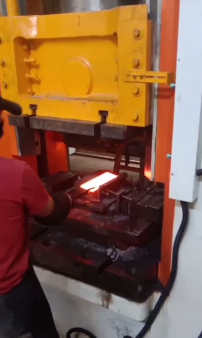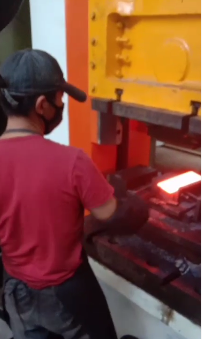Stainless steel is not only corrosion-resistant material, can also be made of heat-resistant material, can also be made of low-temperature materials and non-magnetic materials。
From the point of chemical composition, chromium stainless steel mass fraction is generally over 12%, also contains one or more other alloying elements, the result of the comprehensive effects of alloying elements, the three basic types of stainless steel, the Austenitic,Markov shape,
iIron element size, and between the three types and derived from other types of stainless steel.
Austenitic and ferrite stainless steel ,due to the phase free recrystallization transformation during heating and cooling, the control of the grain size of forgings produced by the steel forging press mainly depends on the temperature of initial forging and final forging, as well as the control of the deformation at the final forging temperature. The heating temperature of austenitic and martensitic stainless steel forgings is mainly limited by the formation temperature of high temperature ferrite.
Ferrite stainless steel is easy to grow in the heating process. In order to obtain fine grain structure and reduce the sensitivity of intergranular corrosion and notch, it should be forged at a low temperature as far as possible. Generally, the initial forging temperature is 1120℃ and the final forging temperature is 700~800℃, and it is not allowed to be higher than 800℃
The initial forging temperature of martensitic stainless steel is generally 1150℃, and the final forging temperature varies with its carbon content. The high carbon one is 925℃, and the low carbon one is 850℃. Both of them should be higher than the isomorphic transformation temperature of steel.
The initial forging temperature range of austenitic stainless steel is generally 1150~1200℃, and the initial forging temperature is generally 825~850℃. The initial forging temperature range of precipitated hardened stainless steel is generally 1120~1180℃, and the initial forging temperature is generally 850~950℃. For martensite body, the initial forging temperature is 1180℃, and the final forging temperature is not lower than 850℃.


In order to ensure corrosion resistance, stainless steel should be heated in a protective atmosphere, neutral atmosphere or micro oxidation atmosphere, not in a reductive atmosphere or excessive oxidation heating, and not directly spray flame on the blank.
Forgings forged by steel forging press should not stay in the high temperature zone for too long, otherwise it is easy to cause serious oxidation, element dilution and grain coarsening. Due to the special structure of stainless steel, the cooling after forging should be controlled.
For stainless steel forgings, the process arrangement of using the forging press for pressure processing should not only consider the good formability and technicality of plastic deformation, but also obtain fine dispersed carbide particles through reasonable pressure processing and subsequent processing.
When alpha phase is present in austenitic stainless steel, it is easy to crack at the interface of two phase when forging by steel forging press. The austenitic stainless steel raw materials have a lot of a, in order to avoid cracking during forging, should not take forging hammer upsetting, punching and other processes with a large amount of tensile stress.